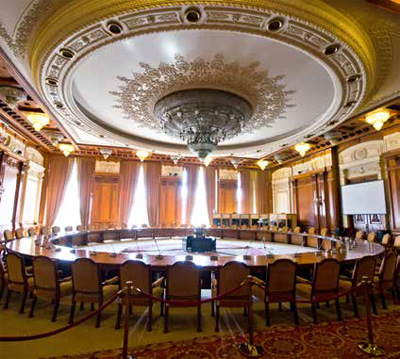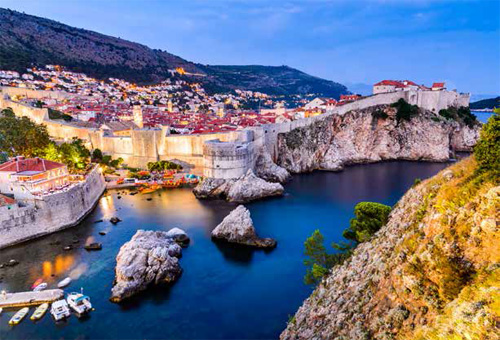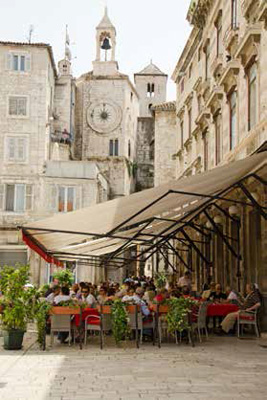Pockets of Romania’s capital city harbor half-shadows from the difficult days of Communist rule and a tumultuous past of debilitating earthquakes and riots. As Bucharest recovers from its temporary unrest and its buildings and history rise from the ashes, the city and its people carry on with unfaltering aplomb. The once-struggling city in Eastern Europe has grown to become the heart of Romania’s industrial and financial sectors. Once considered “Little Paris,” Bucharest’s homage to its pre-war past encourages an era of re-emergence in Europe’s cultural repertoire.
Periodic pauses from offices and conference halls lure visitors to Piaţa Universităţii (University Square), where in 1990 students gathered in a peaceful-turned-violent, anti-Communism protest. Today the National Theatre and Sutu Palace call the bustling square their home. A short walk from the square’s InterContinental hotel, which towers in the distance, sits the uniquely designed and colorful St. George’s Church, a stunning display of artwork and architecture within the walls of an unassuming edifice.
Slightly south of Piaţa Universităţii lies Bucharest’s Old Town, also known as Lipscani. Following a serious and fairly recent transformation, this neighborhood is considered one of the world’s youngest old towns. Meander through the cobblestone streets before dipping into Pura Vida Sky Bar for an end-of-day cocktail at Lipscani’s only rooftop bar.

Interior of the Parliament building in Bucharest, Romania © CCAT82 | DREAMSTIME.COM
There is simply no way to avoid the behemoth that is Bucharest’s Parliament building. The world’s second-largest administrative building (only after the U.S. Pentagon) resides a few blocks southwest of Old Town. Construction began in 1984 and continues to this day. Purchase entry tickets in advance, as the only way to peruse the interior’s 3,100 rooms is with an official guide.
For a real respite from long days trapped indoors at meetings and seminars, head outside to Herăstrău Park. Situated north of Bucharest’s center, the massive space comprises large lakes, a Japanese garden and expansive green fields that take you miles away from the chaotic Romanian capital. Dine at one of the restaurants or check with the tourism office for performance schedules at the open-air theater.
Approximately 3.5 hours southwest of Bucharest rests a discrete paradise where fantasy evolved from a volatile past and where harmony now echoes from the valley of towns nestled between the mountains and the Adriatic Sea. Stretching from the bustling resort town of Split to the well-preserved medieval city of Dubrovnik in the south, Croatia’s Dalmatian Coast is littered with islands just as captivating as the coast itself.

Old Town of Dubrovnik as viewed from Lovrijenac Fortress © EMICRISTEA | DREAMSTIME.COM
Split, the central point of the Dalmatian Coast, possesses all the expected qualities of a coastal city: stalls selling postcards and sachets of lavender, a harbor full of yachts and sailboats, and visitors wandering along the promenade in sun hats and flip-flops.
At night, the promenade and streets of the Old Town come alive as traditional Croatian music wafts through the outdoor bars and restaurants. Just before sunset, climb the sequence of stairs to Marjan Park and enjoy a cool glass of Croatian wine at the hilltop Vidilica Café along with views of the city, seaport and mountains in the distance.
Staying on land while visiting the Dalmatian Coast would be an immense disservice to the 79 islands that dot the striking Adriatic Sea. When it’s too difficult to choose from the islands, commit to visiting the following two by boat.
Hvar is a slender strip of an island located just off the coast of Split. Known to be a favorite of both Prince Harry and Beyoncé (the latter named her first-born child after an indigenous blue ivy that grows on the island), Hvar’s Old Town is not as posh as one might surmise. Open plazas serve as the central organ to which the veins of the winding alleys flow.
Hvar Island earned the nickname Lavender Island because its dry, warm climate lends itself to the cultivation of the aromatic plant. On the island of Hvar, it is difficult to avoid the flower in almost any buyable form, from lavender gelato to lavender oil. Uses of the oil range from a sleep-inducing aid to a mosquito repellant, and all its varieties are sold in shacks along the water’s edge.
Above the hill of Hvar Town stands the towering fortress with views that stretch over the harbor. Yachts of the rich and famous pull up with their guests who seek a warm escape from the more populated coastal towns.

A café in Split, Croatia © ABSENTE | DREAMSTIME.COM
A tour of Split’s sister islands continues to the neighboring Brač (rhymes with “watch”), the largest island among the Split-centric cluster. The abundance of limestone and dolomite contributed to the construction of buildings throughout the region since the days of Roman rule.
Brač cuisine specializes in using every part of milk-fed lamb in a dish called vitalac. The lamb’s entrails are roasted on skewers, rubbed with grass and finished off with a few splashes of wine or Prosecco.
Scenic bus routes from Split to southern parts of Croatia include two options for the 150-mile journey. Whether traveling along the coast and past hillside towns or through the countryside with periodic intra-mountain tunnels, the terrain and views are nothing short of spectacular.
From above and beyond the sea, Dubrovnik resembles a mythical land where fairy tales are born and history lives eternally. After a few steps into the walled city, visitors are transported to the days of pirate ships, sky-kissing castles and medieval rule. With origins that date to the seventh century, Dubrovnik transitioned through time as one of the most well-preserved UNESCO World Heritage sites.
A sea of coral- and salmon-colored rooftops gleams underneath the coastal sunshine as boats dock ashore and deliver fresh catches of the day. The cradle of Croatian cuisine rests along the shores of Dubrovnik, a view one can capture from many a seaside restaurant. Just outside the walls of the Old City sits Dubravka, an upscale café serving fresh dishes with a romantic dash complemented by the patio views that peer through two medieval towers and out to the sea.
Athletic travelers looking for an invigorating climb with rewarding views can hike 90 minutes up to the top of Mount Srđ. Alternatively, a cable car transports passengers from Dubrovnik to the top of the mountain for approximately $9. Once atop the 1,350-foot mountain, the entire city presents itself, and it suddenly becomes clear just how easily Dubrovnik became a fishing and trading port for the entire Adriatic Sea. The Srđ Imperial Fort also rests at the top of the hill, a monument that played a critical role in Croatia’s history. Within the Museum of Croatian War of Independence visitors can learn more about the fort’s use since its construction during the Napoleonic Wars until as recently as the 1990s.
Back down at sea level, make a point to seek out the clandestine Café Buza, a bar that practically hangs from the cliffs outside the walled city. Just after sunset, Dubrovnik’s Old Town erupts with activity as street musicians perform for lovebirds nursing pitchers of Croatian wine.
Romania and Croatia may appear as polar opposites in terms of landscape, climate and general ambience, but together the two nations within the eclectic region of Eastern Europe bear personalities and histories which unearth a new world of possibilities.
Info to Go
Henri Coandă International Airport (also known as Otopeni Airport) lies approximately 10 miles north of Bucharest. Bus 783 travels to the center of the city every 15 minutes on weekdays and every 30 minutes on weekends. The 45- to 60-minute ride costs about $1.75. For $2 take the train, departing hourly from the airport, 35 minutes to Gara de Nord. A taxi from the airport costs approximately $17.50.
Split (Resnik) Airport, 15 miles northwest of the city, offers two bus options to Split with a ride time of 40 minutes: Bus 37 ($3) and the Pleso Prijevoz airport bus service ($4.45).
From Dubrovnik Airport, Atlas Croatia travel agency offers bus service to Dubrovnik’s Old City and the main bus station (approximately 30 minutes). Tickets cost $6 one way and $10 roundtrip. Departure times vary by day; check the Atlas website.
Bus travel between Split and Dubrovnik takes four to five hours, depending on the route and bus service. GetByBus offers competitive fares from various bus lines with multiple departures each day. Purchase tickets in advance or at the main bus terminals in each city.

Introducing
FX Excursions
FX Excursions offers the chance for once-in-a-lifetime experiences in destinations around the world.
#globility
Insta FeedDaily
Dec 13, 2024The Ritz-Carlton, Sarasota Launches Holiday Programming
The Ritz-Carlton, Sarasota invites travelers to experience the magic of the holiday season with a full lineup of festive programming.
Sponsored Content
Pick Your Paradise: Experience Bali at 3 Incredible Hotels
Bali is a name synonymous with island bliss. But there is more than just one side to this incredible place. Get a sense for the variety of experiences Bali offers by learning about three hotels participating in Marriott Bonvoy® with distinctive opportunities for adventure and relaxation. With the Marriott Bonvoy Boundless® Card, earn points for free nights at each of these properties.
Daily
Dec 13, 2024Rediscover Bambu Indah: Transformative Luxury and Green Beauty in Ubud’s Agrarian Riverside
Bambu Indah is a one-of-a-kind boutique hotel high on the Sayan Ridge, 15 minutes from the town of Ubud on the island of Bali in Indonesia. Surrounded by rice paddies, nestled among jungle trees and situated along the great Ayung River, Bambu Indah is an authentic nature sanctuary.
Daily
Dec 13, 2024Taste Your Way Through Japan with These Unique Experiences
Ever wanted to embark on an udon-tasting journey around one of Japan’s prefectures? How about a soy-sauce tasting on an island? Up your trip to Japan with these unique, culinary-inspired experiences, sure to leave you with a full belly and some good stories.
Sponsored Content
Madrid: The Charm of an Authentic City
They say Madrid is in vogue for many reasons: its lifestyle, its heritage, its cuisine and all of its new attractions. And it’s true, because Madrid is on the radar of travelers looking for a cutting-edge destination that still holds onto its essence. Join us as we explore its charms.
Daily
Dec 12, 2024Indulge in Holiday Decadence at London’s St. James’s Hotel & Club, an Althoff Collection Hotel
The elegant, 5-star St. James’s Hotel & Club, an Althoff Collection Hotel, rolls out the Yule Tide welcome log this season with holiday treats that include special menus, caroling, a Festive Afternoon Tea, and views from its roof gardens and private suite terraces of New Year’s Eve fireworks bursting over the city. Decorated Christmas trees and baskets of clementines adorn guestrooms and suites, and this year’s Nutcracker theme will be evident in tree ornaments, banister decorations and red-and-green nutcracker figurines greeting guests as they arrive at the hotel.
6 Raffles Hotels & Resorts for Holiday Experiences
Daily
Dec 12, 2024Orient Express Announces First-Ever Hotel
Daily
Dec 12, 2024Canne Bianche Lifestyle & Hotel Review
eFlyer Reviews
Dec 11, 2024eFlyer News
Dec 11, 2024Viking Names and Delivers Newest Ship in Italy
It’s been a month to remember for Viking, with the luxury cruise line announcing the name and delivery of its newest ocean ship, Viking Vela. The new boat joins Viking’s growing fleet of award-winning ocean ships and will spend her inaugural season sailing in the Mediterranean and Northern Europe.
Sponsored Content
Royal Air Maroc Relaunches Direct Casablanca–Beijing Route, Debuts Toronto Flight
As part of its international network expansion, Royal Air Maroc will reinstate the direct Casablanca–Beijing route initially launched in January 2020 and suspended just a few weeks later due to the health crisis.
eFlyer News
Dec 11, 2024W Hotels Debuts in Prague
W Hotels continues its global expansion of luxury lifestyle hotels with the launch of W Prague. W Prague marks a new chapter for the building, formerly the Art Nouveau-style Grand Hotel Evropa. W Prague lies on Wenceslas Square and offers 161 stylishly appointed guestrooms and suites.
ShareThis